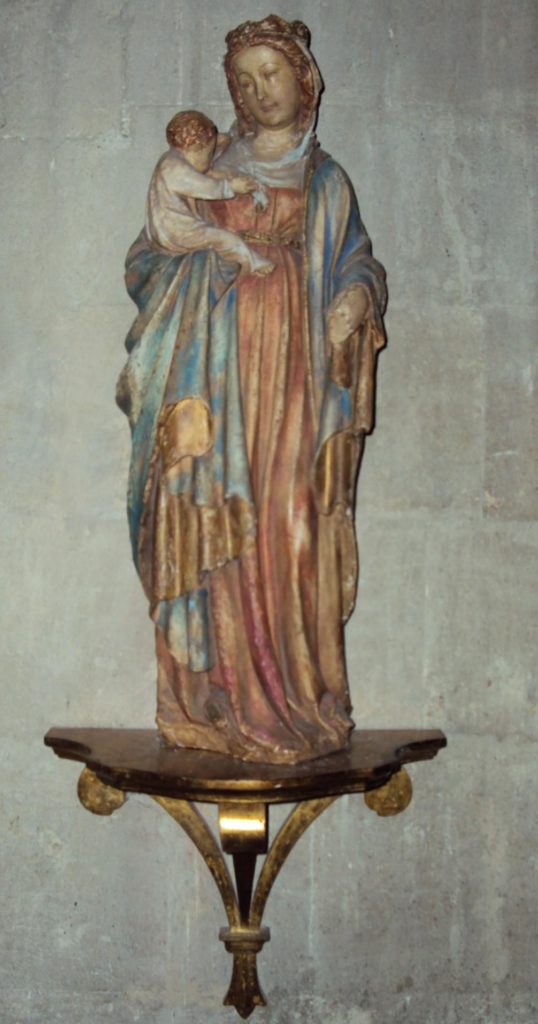
Virgin of Loving Kindness
Gaze into the chancel before a service begins and the eye settles on the warmth of the tapestry or, if you pitch your gaze higher, on the youthful Christ in Glory. Bring your attention forwards and you might catch the gilding on the angels on either side of the arch. But as we settle into our pews and quieten our hearts for the coming prayers, our focus might broaden to embrace the tender little statue of the Virgin and Child that currently stands next to the hymn board, on the left. She has been gracing our church since 1956, at least. The original is in the Medieval and Renaissance Gallery at the Victoria and Albert in London.
Our copy was a gift from the Mothers’ Union, noted for the first time in the Parish Magazine in 1956. By the time the art historian Elias Polomski had joined Holy Trinity as curate in 1990 the plaster was chipped and the statue “garishly painted”. So, feeling there was little to lose, Father Elias took the statue home and got going on the gaudy paint with wire wool and turpentine. “I had no professional knowledge: it wasn’t subtle work but I did have a sensitive eye.”
Fr Elias went through stages of stripping and experimenting. “It couldn’t look a lot worse than it did” so he felt he was unlikely to do much harm. “I just went at it until it looked mellow: subdued, elegant, quiet.” The result now looks like pitted wood; as though our statue has, like its original, existed 600 years and been worked on and faded by time. Fr Elias added a hint of gold enamel here and there with a small brush. “Otherwise, my work was just to take away.”
The child leans his head close to his mother’s right breast, which he is discretely suckling, and rests a foot on her belly. His right hand is pushing away the material of her robe from the breast. The sweet, intimate quality is typical of Gothic sculpture at the end of the 1300s: the marble original, which would have been created in northern France or the southern Netherlands, is dated between 1390 and 1410. Our plaster copy is identical, which is why the Virgin has no left hand. Even the decision by some enthusiast to paint it up is in keeping with late medieval custom because traces of paint and gilding have been found on the now ivory-coloured original.
In the opinion of the V&A, this statue was probably an individual image to which prayers could be addressed. Wherever we in the Anglo-Catholic church stand individually on the cult of the Virgin Mary, our statue is an intimate picture of affection and love we can all recognise and, perhaps, be inspired by. The work is in the Byzantine tradition of the Virgin of Loving Kindness that had been introduced into Western Christendom by Bernard of Clairvaux (1090-1153). Think of the austere icons of Eastern Christianity of the Queen of Heaven and her Child and contrast these images with this statue, created to show the devotion of Jesus and his mother. Icons of Loving Kindness are a type: the Hodegetria (‘she who shows the way’) – the Virgin in Russian icons, which derive from Eastern Christianity. Glykophilousa (‘the sweet kissing of the mother of God’), which is also Byzantine. And Eleoussa (‘Virgin of Loving Kindness’, or of affectionate tenderness), which is closest to ours. Google Images has plenty of examples.
Look at the rhythmic and graceful fall of the virgin’s drapery. Note the hip shot pose (‘hip shot’ is a technical term), with the weight of the body arching to support the weight of the child. See how the young mother gazes in watching love as her child feeds. This is the language of love that Christianity finds easiest to express through the mother.
When the day grows late and those who follow the rhythm of the canonical hours (Lauds, Prime, etc), gather for the final office of the day, Compline, it is towards a statue of a Virgin and Child like this one that Catholics turn for their final prayer, the Salve Regina: O Clemens, O pia, O dulcis, Virgo Maria – Oh gentle, Oh loving, Oh sweet Virgin Mary.
Thank you to the Reverend Elias Polomski, who travelled to Headington especially to talk about this statue and share his scholarship
